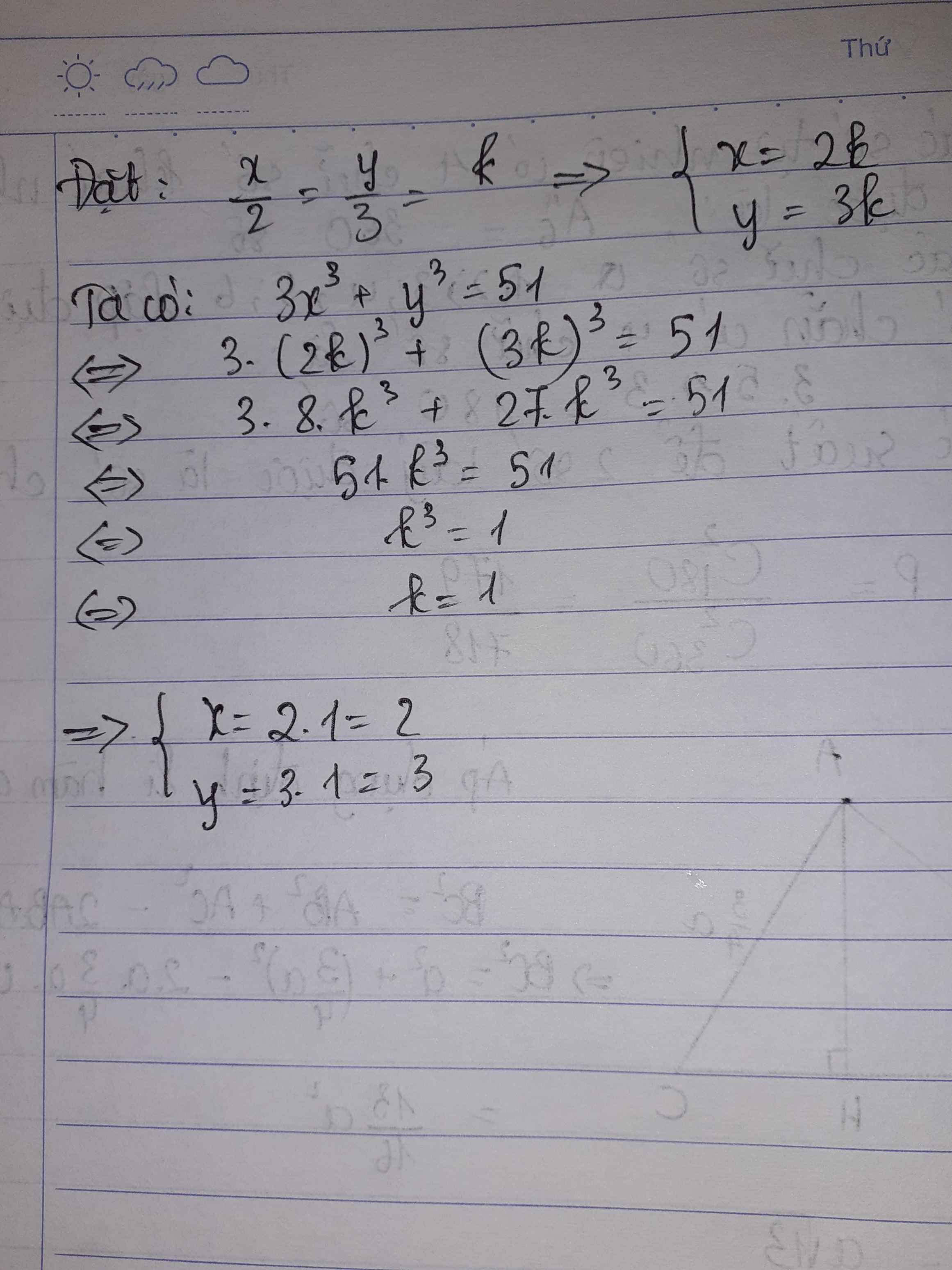Hãy nhập câu hỏi của bạn vào đây, nếu là tài khoản VIP, bạn sẽ được ưu tiên trả lời.

`3x-15/(5*8)-15/(8*11)-15/(11*14)-...-15/(47*50)=2 1/10`
`3x-(15/(5*8)+15/(8*11)+15/(11*14)+...+15/(47*50))=21/10`
`3x-5(3/(5*8)+3/(8*11)+3/(11*14)+...+3/(47*50))=21/10`
`3x-5(1/5-1/8+1/8-1/11+1/11-1/14+...+1/47-1/50)=21/10`
`3x-5(1/5-1/50)=21/10`
`3x-5*9/50=21/10`
`3x-9/10=21/10`
`3x=21/10+9/10`
`3x=3`
`x=1`

\(\dfrac{1}{3}+\dfrac{1}{6}+\dfrac{1}{10}+...+\dfrac{1}{x.\left(2x+1\right)}=\dfrac{1}{10}\)
\(\Leftrightarrow\dfrac{1}{6}+\dfrac{1}{12}+\dfrac{1}{20}+...+\dfrac{1}{2x.\left(2x+1\right)}=\dfrac{1}{20}\)
\(\Leftrightarrow\dfrac{1}{2.3}+\dfrac{1}{3.4}+\dfrac{1}{4.5}+...+\dfrac{1}{2x.\left(2x+1\right)}=\dfrac{1}{20}\)
\(\Leftrightarrow\dfrac{1}{2}-\dfrac{1}{3}+\dfrac{1}{3}-\dfrac{1}{4}+\dfrac{1}{4}-\dfrac{1}{5}+...+\dfrac{1}{2x}-\dfrac{1}{2x+1}=\dfrac{1}{20}\)
\(\Leftrightarrow\dfrac{1}{2}-\dfrac{1}{2x+1}=\dfrac{1}{20}\)
\(\Leftrightarrow\dfrac{1}{2x+1}=\dfrac{9}{20}\)
\(\Leftrightarrow2x+1=\dfrac{20}{9}\Leftrightarrow x=\dfrac{11}{18}\)
Em giải như XYZ olm em nhé
Sau đó em thêm vào lập luận sau:
\(x\) = \(\dfrac{11}{18}\)
Vì \(\in\) N*
Vậy \(x\in\) \(\varnothing\)

\(\dfrac{1}{1.4}+\dfrac{1}{4.7}+\dfrac{1}{7.10}+...+\dfrac{1}{x\left(x+3\right)}=\dfrac{125}{376}\)
\(\Leftrightarrow\dfrac{1}{3}\left(1-\dfrac{1}{4}+\dfrac{1}{4}-\dfrac{1}{7}+\dfrac{1}{7}-\dfrac{1}{10}+...+\dfrac{1}{x}-\dfrac{1}{x+3}\right)=\dfrac{125}{376}\)
\(\Leftrightarrow\dfrac{1}{3}\left(1-\dfrac{1}{x+3}\right)=\dfrac{125}{376}\left(x\ne0;x\ne-3\right)\)
\(\Leftrightarrow\dfrac{x+3-1}{x+3}=\dfrac{3.125}{376}\Leftrightarrow\dfrac{x+2}{x+3}=\dfrac{3.125.}{376}.\dfrac{\left(x+3\right)}{x+3}\)
\(\Leftrightarrow376\left(x+2\right)=3.125.\left(x+3\right)\)
\(\Leftrightarrow376x+752=375x+1125\)
\(\Leftrightarrow376x-375x=1125-752\Leftrightarrow x=373\left(x\in N^{\cdot}\right)\)

\(\dfrac{x}{3}-2=\dfrac{1}{15}\)
=>\(\dfrac{x}{3}=2+\dfrac{1}{15}=\dfrac{31}{15}\)
=>\(x=\dfrac{31}{15}\cdot3=\dfrac{31}{5}\)

a: Xét ΔDOE vuông tại O và ΔKOE vuông tại O có
EO chung
\(\widehat{DEO}=\widehat{KEO}\)
Do đó: ΔDOE=ΔKOE
b: Xét ΔEDI vàΔEKI có
ED=EK
\(\widehat{DEI}=\widehat{KEI}\)
EI chung
Do đó: ΔEDI=ΔEKI
Suy ra: \(\widehat{EDI}=\widehat{EKI}=90^0\)
hay IK\(\perp\)FE
c: Xét ΔDIQ vuông tại D và ΔKIF vuông tại K có
ID=IK
\(\widehat{DIQ}=\widehat{KIF}\)
Do đó: ΔDIQ=ΔKIF
Suy ra: IQ=IF

Đây là toán nâng cao chuyên đề tìm phương trình nghiệm nguyên, cấu trúc thi chuyên, thi học sinh giỏi các cấp. Hôm nay, Olm sẽ hướng dẫn các em giải chi tiết dạng này bằng phương pháp đánh giá như sau:
Giải:
20\(^x\) : 14\(^x\) = \(\dfrac{10}{7}\)\(x\) (\(x\) \(\in\) N)
\(\left(\dfrac{20}{14}\right)^x\) = \(\dfrac{10}{7}\)⇒ \(x\)\(\left(\dfrac{10}{7}\right)^x\) = \(\dfrac{10}{7}\)\(x\)
\(x\) = \(\left(\dfrac{10}{7}\right)^x\): \(\dfrac{10}{7}\) ⇒ \(x\) =\(\left(\dfrac{10}{7}\right)^{x-1}\)
Nếu \(x\) = 0 ta có 0 = (\(\dfrac{10}{7}\))-1 = \(\dfrac{7}{10}\) (vô lý)
Nếu \(x\) = 1 ta có: 1 = \(\left(\dfrac{10}{7}\right)^{1-1}\) = 1 (nhận)
Nếu \(x\) > 1 ta có: \(x\) \(\in\) N mà (\(\dfrac{10}{7}\))\(x\) không phải là số tự nhiên nên
\(x\) \(\ne\) (\(\dfrac{10}{7}\))\(x-1\) (loại)
Từ những lập luận trên ta có \(x\) = 1 là số tự nhiên duy nhất thỏa mãn đề bài.
Vậy \(x\) = 1

\(\dfrac{1}{15}\) + \(\dfrac{1}{21}\) + \(\dfrac{1}{28}\) + \(\dfrac{1}{36}\) +...+ \(\dfrac{2}{x\left(x+1\right)}\) = \(\dfrac{11}{40}\) (\(x\in\) N*)
\(\dfrac{1}{2}\).(\(\dfrac{1}{15}\)+\(\dfrac{1}{21}\)+\(\dfrac{1}{28}\)+\(\dfrac{1}{36}\)+.....+ \(\dfrac{2}{x\left(x+1\right)}\)) = \(\dfrac{11}{40}\) \(\times\) \(\dfrac{1}{2}\)
\(\dfrac{1}{30}\) + \(\dfrac{1}{42}\) + \(\dfrac{1}{56}\) + \(\dfrac{1}{72}\)+...+ \(\dfrac{1}{x\left(x+1\right)}\) = \(\dfrac{11}{80}\)
\(\dfrac{1}{5.6}\) + \(\dfrac{1}{6.7}\) + \(\dfrac{1}{7.8}\)+...+ \(\dfrac{1}{x\left(x+1\right)}\) = \(\dfrac{11}{80}\)
\(\dfrac{1}{5}\) - \(\dfrac{1}{6}\) + \(\dfrac{1}{6}\) - \(\dfrac{1}{7}\) + \(\dfrac{1}{7}\) - \(\dfrac{1}{8}\) + \(\dfrac{1}{8}\)-\(\dfrac{1}{9}\)+...+ \(\dfrac{1}{x}\)-\(\dfrac{1}{x+1}\) = \(\dfrac{11}{80}\)
\(\dfrac{1}{5}\) - \(\dfrac{1}{x+1}\) = \(\dfrac{11}{80}\)
\(\dfrac{1}{x+1}\) = \(\dfrac{1}{5}\) - \(\dfrac{11}{80}\)
\(\dfrac{1}{x+1}\) = \(\dfrac{1}{16}\)
\(x\) + 1 = 16
\(x\) = 16 - 1
\(x\) = 15


Ta có: \(20^x:14^x=\dfrac{10}{7}x\)
\(\Leftrightarrow\left(\dfrac{10}{7}\right)^x=\dfrac{10}{7}x\)
\(\Leftrightarrow x=\left(\dfrac{10}{7}\right)^{x-1}\)
Đến đây mình bí rồi, xin lỗi bạn!